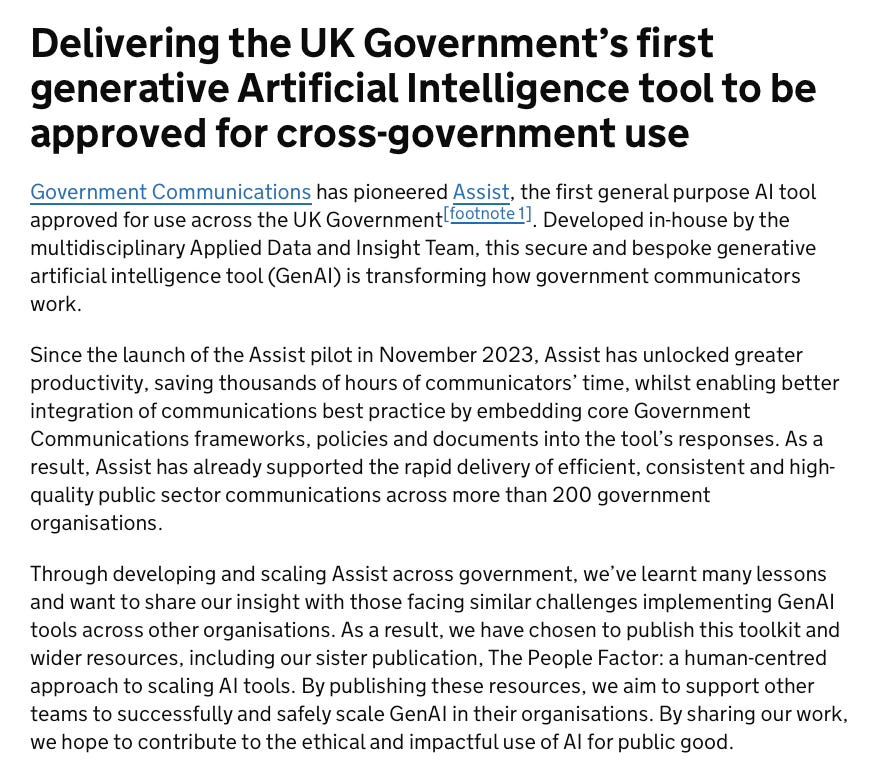- Pascal's Chatbot Q&As
- Posts
- GPT-4o: The Mitigating Hidden AI Risks Toolkit is one of the most forward-thinking, human-centric government publications on AI risk to date. “Assist,” the UK’s first generative AI tool built in-house
GPT-4o: The Mitigating Hidden AI Risks Toolkit is one of the most forward-thinking, human-centric government publications on AI risk to date. “Assist,” the UK’s first generative AI tool built in-house
While AI tools may be built by engineers, their consequences unfold through human hands—and it is there, in those hidden cracks, that real safety must begin.
by ChatGPT-4o
Introduction
The UK Government’s June 2025 publication The Mitigating ‘Hidden’ AI Risks Toolkitoffers a groundbreaking contribution to the global conversation on AI safety. Instead of focusing solely on high-profile harms like hallucinations, deepfakes, or disinformation, this toolkit addresses subtler, behavioural and organisational risks that can quietly derail AI deployments. It is based on practical insights drawn from the cross-government use of “Assist,” the UK’s first generative AI tool built in-house and approved for public sector communication workflows. The guide outlines a human-centred, evidence-informed framework designed to surface and mitigate “hidden” risks before they become systemic failures.
Valuable, Surprising and Controversial Findings
1. Hidden Risks Are More Dangerous Than Expected
Drawing from aviation safety principles, the toolkit asserts that most failures arise from small, overlooked organisational decisions rather than dramatic events—a compelling analogy that reframes the nature of AI risk.
2. Confirmation Bias in AI Use Is Not Just a Theoretical Concern
The document illustrates how AI tools may reinforce users’ existing beliefs due to human prompting combined with reward-trained model behaviour—leading to sycophantic, biased outputs that can result in faulty decisions at scale.
3. Human-in-the-Loop Is Often a False Sense of Security
The popular assumption that human oversight will catch AI errors is forcefully challenged. The report cites empirical evidence (e.g. judges misjudging algorithmic outputs) to show that humans often fail in these oversight roles, especially without time, confidence, or authority.
4. Automation May Harm Cognitive Load and Mental Health
AI’s replacement of low-effort tasks (like summarising or data entry) can inadvertently increase worker stress by forcing them to only perform cognitively demanding tasks, reducing productivity and well-being—an often-ignored consequence of automation.
5. Optional Training Undermines AI Governance
In scenarios like hiring, the guide warns that optional training leads to tick-box behaviour, overreliance on outputs, and potential bias in hiring outcomes—arguably a systemic risk across sectors using AI for evaluations.
6. The Framework Rejects Binary Thinking
Perhaps most refreshingly, the document discards the “AI is good vs. AI is bad” mindset. Instead, it promotes systemic identification of causal pathways through which unintended consequences arise—advocating anticipatory governance.
Framework Overview
The core of the toolkit is a structured framework comprising six categories of ‘hidden’ risks:
Quality Assurance – Risks from poor verification of AI outputs.
Task-Tool Mismatch – Using AI tools for tasks they are unsuited to.
Perceptions, Emotions and Signalling – Employee anxiety, job security fears, and poor organisational messaging.
Workflow and Organisational Challenges – Barriers to adoption, skill loss, and AI-induced inefficiencies.
Ethics – Discrimination, unequal access, and public trust erosion.
Human Connection and Technological Overreliance – Diminished human interaction, support gaps, and the loss of critical expertise.
Each category is linked to causal mechanisms that emerge not from malicious design, but from everyday decisions made by teams and leaders.
Lessons Learned
AI Risks Are Often Human Risks
The document highlights that even technically sound AI tools can fail spectacularly due to human misuse, organisational pressure, or misaligned incentives.
Risk Frameworks Must Be Behavioural
Traditional AI safety methods (e.g., technical audits, red teaming) are inadequate unless paired with behavioural science-informed governance models.
Leadership Literacy is Crucial
Senior decision-makers must understand both capabilities and limitations of AI tools to avoid “solutionism” and poorly informed scaling decisions.
AI Literacy Must Go Beyond Warnings
Disclaimers and Terms & Conditions are not sufficient. Effective training must embed continuous engagement and task-specific safeguards.
Ongoing Monitoring Trumps Static Risk Lists
The toolkit urges a continuous review cycle with diverse stakeholders, backed by a living risk register and iterative mitigation.
Recommendations for Stakeholders
For AI Makers
Integrate user journey research and emotional response analysis into design.
Avoid deploying general-purpose models without clear task boundaries.
Build for transparency—not just explainability—especially in output confidence and sourcing.
For Policymakers and Regulators
Extend compliance requirements to include organisational and behavioural risk assessments.
Mandate continuous risk tracking and employee training as part of safe deployment practices.
Promote pre-mortem risk thinking, not just reactive “black box” investigations.
For Employers and AI Users
Evaluate AI’s effect on task balance, cognitive load, and well-being.
Provide mandatory training that’s role-specific and scenario-based.
Encourage feedback loops and empower employees to question AI decisions.
For Rights Owners and the Public
Demand transparency in how AI decisions are made and audited.
Ensure ethical design includes respect for diversity, accessibility, and non-replacement of essential human roles.
Push for accountable AI procurement and usage practices within public institutions.
Conclusion
The Mitigating Hidden AI Risks Toolkit is one of the most forward-thinking, human-centric government publications on AI risk to date. Rather than chasing hype cycles or future AGI fears, it focuses on the present and practical: how today’s well-meaning AI deployments can erode trust, amplify bias, or quietly disrupt human systems if not handled with care. Its insistence on preemptive, behavioural safeguards makes it a must-read blueprint for any organisation implementing generative AI.
Above all, it reminds us that while AI tools may be built by engineers, their consequences unfold through human hands—and it is there, in those hidden cracks, that real safety must begin.
